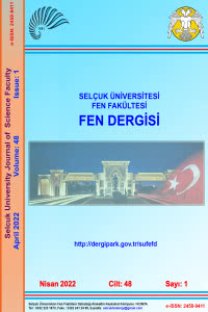C-H Grupları ile Bor Atomlarının Yer Değiştirmesi Sonucunda B6-nCnHn (n=0-6) Serilerinin Yapısal ve Elektronik Özellikleri: Bir Yoğunluk Fonksiyonel Teori Çalışması
STRUCTURAL AND ELECTRONIC PROPERTIES OF B6-nCnHn (n=0-6) SERIES UPON THE SUBSTITUTION OF BORON ATOMS BY THE C-H GROUPS: A DENSITY FUNCTIONAL THEORY STUDY
___
- Alexandrova AN, Boldyrev AI, Zhai HJ, et al (2003) Structure and bonding in B6(-) and B6: Planarity and antiaromaticity. J Phys Chem A 107:1359–1369. doi: 10.1021/jp0268866
- Barth RF, Coderre JA, Vicente MGH, Blue TE (2005) Boron neutron capture therapy of cancer: Current status and future prospects. Clin Cancer Res 11:3987–4002. doi: 10.1158/1078-0432.CCR-05-0035
- Becke AD (1993) A new mixing of hatree-fock and local density functional theories. J Chem Phys 98:1372–1377. doi: 10.1063/1.464304 Dennington R, Keith TA, Millam JM (2009) GaussView 5.0.9
- Dinadayalane TC, Priyakumar UD, Sastry GN (2004) Exploration of C6H6 potential energy surface: A computational effort to unravel the relative stabilities and synthetic feasibility of new benzene isomers. J Phys Chem A 108:11433–11448. doi: 10.1021/jp0467696
- El-Zaria ME, Arii H, Nakamura H (2011) m-Carborane-Based Chiral NBN Pincer-Metal Complexes: Synthesis, Structure, and Application in Asymmetric Catalysis. Inorg Chem 50:4149–4161. doi: 10.1021/ic2002095
- Frisch MJ, Trucks GW, Schlegel HB, Scuseria GE, Robb MA, Cheeseman JR, Scalmani G, Barone V, Mennucci B, Petersson GA, Nakatsuji H, Caricato M, Li X, Hratchian HP, Izmaylov AF, Bloino J, Zheng G, Sonnenberg JL, Hada M, Ehara M, Toyota K, Fukuda R, Hasegawa J, Ishida M, Nakajima T, Honda Y, Kitao O, Nakai H, Vreven T, Montgomery JA, Peralta JE, Ogliaro F, Bearpark M, Heyd JJ, Brothers E, Kudin KN, Staroverov VN, Kobayashi R, Normand J, Raghavachari K, Rendell A, Burant JC, Iyengar SS, Tomasi J, Cossi M, Rega N, Millam JM, Klene M, Knox JE, Cross JB, Bakken V, Adamo C, Jaramillo J, Gomperts R, Stratmann RE, Yazyev O, Austin AJ, Cammi R, Pomelli C, Ochterski JW, Martin RL, Morokuma K, Zakrzewski VG, Voth GA, Salvador P, Dannenberg JJ, Dapprich S, Daniels AD, Farkas Foresman JB, Ortiz JV, Cioslowski J, Fox DJ (2009) Gaussian 09, Revision B.01.
- Galeev TR, Boldyrev AI (2011) Planarity takes over in the CxHxP6-x (x=0-6) series at x=4. Phys Chem Chem Phys 13:20549–20556 . doi: 10.1039/c1cp21959f
- Grimes RN (2013) Synthesis and serendipity in boron chemistry: A 50 year perspective. J Organomet Chem 747:4–15. doi: 10.1016/j.jorganchem.2013.04.018
- Ivanov AS, Boldyrev AI (2012) Si6-nCnH6 (n=0-6) series: when do silabenzenes become planar and global minima? J Phys Chem A 116:9591–9598. doi: 10.1021/jp307722q
- Ivanov AS, Bozhenko K V, Boldyrev AI (2012) Peculiar Transformations in the CxHxP4-x (x=0-4) Series. J Chem Theory Comput 8:135–140. doi: 10.1021/ct200727z
- Jemmis ED, Balakrishnarajan MM, Pancharatna PD (2002) Electronic requirements for macropolyhedral boranes. Chem Rev 102:93–144. doi: 10.1021/cr990356x
- Jemmis ED, Kiran B, Coffey D (1997) Ab initio studies on disubstituted closo-icosahedral heteroboranes, X2B10H10 (X=CH, SiH, N, P, and Sb). Chem Berichte-Recueil 130:1147–1150. doi: 10.1002/cber.19971300818
- Jiang W, Chizhevsky IT, Mortimer MD, et al (1996) Carboracycles: Macrocyclic compounds composed of carborane icosahedra linked by organic bridging groups. Inorg Chem 35:5417–5426. doi: 10.1021/ic960354k
- Li X (2017) Structural, electronic and spectral properties of carborane-containing boron dipyrromethenes (BODIPYs): A first-principles study. Spectrochim Acta Part A-Molecular Biomol Spectrosc 185:149– 154. doi: 10.1016/j.saa.2017.05.047
- McLemore DK, Dixon DA, Strauss SH (1999) Density functional theory and fluorocarboranes I. Trends in B-H and B-F distances and dissociation energies for CB11H12-nFn- anions (n=0, 1, 6, 11). Inorganica Chim Acta 294:193–199. doi: 10.1016/S0020-1693(99)00285-6
- Muz I, Atis M (2016) Structural transformations in the carborane series: CnB6-nH6 (n=0-6) upon substitution of boron by carbon. Inorganica Chim Acta 453:626–632. doi: 10.1016/j.ica.2016.09.035
- Schleyer P V, Maerker C, Dransfeld A, et al (1996) Nucleus-independent chemical shifts: A simple and efficient aromaticity probe. J Am Chem Soc 118:6317–6318. doi: 10.1021/ja960582d
- Schleyer P V, Najafian K (1998) Stability and three-dimensional aromaticity of closo-monocarbaborane anions, CBn-1Hn-, and closo-dicarboranes, C2Bn-2Hn. Inorg Chem 37:3454–3470. doi: 10.1021/ic980110v
- Scholz M, Hey-Hawkins E (2011) Carbaboranes as Pharmacophores: Properties, Synthesis, and Application Strategies. Chem Rev 111:7035–7062 . doi: 10.1021/cr200038x
- Smith K (1990) Synthetic Chemistry-Boron Molecular Gymnastics. Nature 348:115–116. doi: 10.1038/348115b0
- Soloway AH, Werner Tjarks, Beverly A. Barnum, et al (1998) The Chemistry of Neutron Capture Therapy. Chem Rev 98:1515–1562. doi: 10.1021/cr941195u
- Spokoyny A ~M., Machan C ~W., Clingerman D ~J., et al (2011) A coordination chemistry dichotomy for icosahedral carborane-based ligands. Nat Chem 3:590–596. doi: 10.1038/nchem.1088
- Takano K, Izuho M, Hosoya H (1992) Abinitio Molecular-Orbital Study of Electronic-Structures of ClosoBorane Anions Bnhn2- and Closo-Carboranes C2bn-2hn. J Phys Chem 96:6962–6969. doi: 10.1021/j100196a021
- Valliant JF, Guenther KJ, King AS, et al (2002) The medicinal chemistry of carboranes. Coord Chem Rev 232:173–230. doi: 10.1016/S0010-8545(02)00087-5
- Westerhausen M, Guckel C, Schneiderbauer S, et al (2001) The first barium-carborate complex: Synthesis and structural investigation. Angew Chemie-International Ed 40:1902–1904 . doi: 10.1002/1521- 3773(20010518)40:10<1902::AID-ANIE1902>3.0.CO;2-V
- Williams RE (1976) Coordination Number Pattern Recognition Theory of Carborane Structures*. In: Emeléus HJ, Sharpe AG (eds). Academic Press, pp 67–142
- ISSN: 2147-9364
- Yayın Aralığı: 2
- Başlangıç: 2013
- Yayıncı: Selçuk Üniversitesi Mühendislik Fakültesi
DEVELOPMENT OF A WIRELESS PRESSURE SENSOR MODULE TO CONVERT THE MOBILE PHONES INTO DIVE COMPUTERS
Miraç MEMİŞOĞLU, Tamer ÖZYİĞİT, Seçil ŞATIR, Salih Murat EGİ
TEDARİKÇİ SEÇİMİ UYGULAMALARI: BİLGİ VE İLETİŞİM TEKNOLOJİLERİ PERSPEKTİFLİ BİR LİTERATÜR TARAMASI
Ali Emre KARAÖZ, Göknur Arzu AKYÜZ, Kemal TEKİN
Kalsitin Yaş Öğütülmesinde Öğütücü Ortam Performansının Etkisi
KİMYASAL BUHAR BİRİKTİRME YÖNTEMİ İLE GRAFEN SENTEZİNE TAVLAMA VE BÜYÜTME SÜRELERİNİN ETKİSİ
Recep ZAN, Gülcan UTKU, Ali ALTUNTEPE
Batuhan Eren ENGİN, Turan PAKSOY
KİTOSAN/ter(GMA-MA-NTBA) POLİMER İLE MİKROKAPSÜL HAZIRLAMA VE KARAKTERİZASYONU
İsmail Kutlugün AKBAY, Tonguç ÖZDEMİR, Rükan GENÇ, Ahmet GÜNGÖR
SERVQUAL ÖLÇEĞİ İLE YAŞLI BAKIMEVLERİNDE HİZMET KALİTESİNİN ÖLÇÜMÜ
KARMAŞIK DALGACIK DÖNÜŞÜMÜ TABANLI YAPAY SİNİR AĞLARI İLE YÜZ ALGILAMA
NVESTIGATING USE OF PRESSURE PULSES TO ASSESS NEAR WELLBORE RESERVOIR PARAMETERS
